Experimental Investigation on the Influence of Oven-Drying on the Geotechnical Properties of Volcanic Ash-Derived Residual Soils
Abstract
:1. Introduction
1.1. The Genesis of Soil-Derived Volcanic Ash
1.2. Morphology of Allophane and Imogolite
2. Materials and Methods
2.1. Geological Context and Sample Location
2.2. Sample Description
2.3. Methods and Regulations
2.3.1. Particle Size Distribution
2.3.2. Plasticity
2.3.3. Specific Gravity
2.3.4. Modified Proctor
2.3.5. California Bearing Ratio (CBR)
2.3.6. Compressibility
2.3.7. Undrained Shear Strength
2.3.8. Drained Shear Strength
3. Results and Discussion
3.1. Particle Size Distribution
3.2. Atterberg Limits
3.3. Soil Classification
3.4. Specific Gravity
3.5. Modified Proctor
3.6. California Bearing Ratio (CBR)
3.7. Compressibility
3.8. Undrained Shear Strenght
3.9. Drained Shear Strenght
4. Summary and Conclusions
- The plastic behavior soil moisture range was considerably reduced by oven-drying. Both undisturbed and oven-dried samples classify as MH using the Unified Soil Classification System, as described in the ASTM D2487 standard.
- Specific gravity tests were performed following procedures A and B described in the ASTM D 854 standard, with similar results for both methods. The mean specific gravity of particles determined were 2.44 and 2.49 for undisturbed and oven-dried samples, respectively. However, other authors have reported values close to 2.7 for the same type of soil [6,10,11].
- The maximum dry density obtained with the modified Proctor tests increases noticeably (12%) with oven-drying, and the optimum water content decreases (−28%)
- The Californian Bearing Ratio (CBR) obtained on undisturbed and oven-dried samples, determined at the penetration of 5.08 mm, is 15.4% and 29.4%, respectively. With these results, the material could be used as a subgrade or subbase, depending on material condition. Thus, commercial laboratories should not dry allophanic soil samples in the oven to measure the CBR due to significant changes in their results.
- The initial void ratio of undisturbed allophanic soils is considered high in comparison with most sedimentary soils. The mean coefficient of compressibility (mv) determined for undisturbed and oven-dried samples in the range between 40 and 200 kPa of vertical effective stress was obtained. In these conditions, the value of the coefficient of compressibility was 6.42·10−3 and 9.70·10−3 kPa−1 for the undisturbed and oven-dried samples, respectively. It was verified that the oedometer test could not determine adequately the value of the coefficient of consolidation (cv) in the usual foundations pressure range (40 to 200 kPa). The aforementioned is explained due to the small number of lectures in which the soil reduces the excess pore pressure in the typical vertical effective stress range used in the design of foundations.
- The sensitivity obtained was near 4, classified as very sensitive soil as proposed by Terzaghi et al. [33].
- A friction angle of 29° and 33° was obtained, while the cohesion was 18.7 kPa and 4.3 kPa, for undisturbed and oven-dried respectively. Minor changes were achieved between the undisturbed and the oven-dried samples considering Mohr–Coulomb failure criterion.
Author Contributions
Funding
Institutional Review Board Statement
Informed Consent Statement
Data Availability Statement
Acknowledgments
Conflicts of Interest
References
- Besoain, E. Génesis y transformación de los minerales de arcilla en suelos derivados de cenizas volcánicas del Centro—Sur de Chile. In Suelos Volcánicos de Chile; INIA: Spring Hill, TN, USA, 1985; p. 723. [Google Scholar]
- Schlatter, J.E.; Grez, R.; Gerding, V. Manual Para el Reconocimiento de Suelos; Universidad Autral de Chile: Valdivia, Chile, 2003; ISBN 956-7105-25-1. [Google Scholar]
- Veblen, T.T. Temperate Forests of the Southern Andean Region. In Temperate Forests of the Southern Andean Region; Oxford University Press: Oxford, UK, 2007. [Google Scholar]
- Börgel Olivares, R. Geomorfología; Geografía de Chile; Instituto Geográfico Militar: Santiago, Chile, 1983. [Google Scholar]
- Wright, C.A. The Volcanic Ash Soils of Chile; Expanded program of technical assistance; Food and Agricultute Organization of The United Nations (FAO): Rome, Italy, 1965. [Google Scholar]
- Varela Cunazza, F.A. Efecto del Tipo de Secado en Las Propiedades Índice y Compresibilidad de Suelos de Origen Volcánico. Bachelor’s Thesis, Universidad de Chile, Santiago, Chile, 2016. [Google Scholar]
- Sanhueza, C.; Palma, J.; Valenzuela, P.; Araneda, O.; Calderón, K. Evaluación del comportamiento geotécnico de suelos volcánicos chilenos para su uso como material de filtro en la depuración de aguas residuales domésticas. Rev. Constr. 2011, 10, 66–81. [Google Scholar] [CrossRef] [Green Version]
- Schlatter, J.E.; Romeny, G.; Madariaga, S. Capacidad de filtro de los suelos del sur de chile a la aplicación de lodos de piscicultura. Agro Sur 2020, 48, 41–59. [Google Scholar] [CrossRef]
- Wesley, L. Behaviour and geotechnical properties of residual soils and allophane clays. Obras Proy. 2009, 6, 5–10. [Google Scholar]
- González Pulgar, C.A. Propiedades Geomecánicas de Dos Suelos de Origen Volcánico. Master’s Thesis, Universidad de Chile, Santiago, Chile, 2012. [Google Scholar]
- Paredes, M. Geotecnia de Suelos Derivados de Ceniza Volcánica. Master’s Thesis, Universidad de Chile, Santiago, Chile, 2005. [Google Scholar]
- Verdugo, R. Singularities of Geotechnical Properties of Complex Soils in Seismic Regions. J. Geotech. Geoenviron. Eng. 2008, 134, 982–991. [Google Scholar] [CrossRef] [Green Version]
- Verdugo, R.; Paredes, M. Comportamiento Geomecánico de Suelos Alofánicos; V Congreso Chileno de Ingeniería Geotécnica: Santiago, Chile, 2004; p. 10. [Google Scholar]
- Lizcano, A.; Herrera, M.C.; Santamarina, J.C. Suelos derivados de cenizas volcánicas en Colombia. Rev. Int. Desastres Nat. Accid. E Infraestruct. Civ. 2006, 6, 167–198. [Google Scholar]
- Wesley, L.D. Some basic engineering properties of halloysite and allophane clays in Java, Indonesia. Géotechnique 1973, 23, 471–494. [Google Scholar] [CrossRef]
- Yuan, G.; Wada, S. Allophane and Imogolite Nanoparticles in Soil and Their Environmental Applications. In Nature’s Nanostructures; Barnard, A., Guo, H., Eds.; CRC Press: Boca Raton, FL, USA, 2012; p. 516. ISBN 978-981-4364-21-8. [Google Scholar]
- Huang, Y.; Lowe, D.; Churchman, G.; Schipper, L.; Cursons, R.; Zhang, H.; Chen, T.; Cooper, A. DNA adsorption by nanocrystalline allophane spherules and nanoaggregates, and implications for carbon sequestration in Andisols. Appl. Clay Sci. 2016, 120, 40–50. [Google Scholar] [CrossRef]
- Parfitt, R.L. Allophane in New-Zealand. Aust. J. Soil Res. 1990, 28, 343–360. [Google Scholar] [CrossRef]
- Wada, S. Imogolite synthesis at 25 °C. Clays Clay Miner. 1987, 35, 379–384. [Google Scholar] [CrossRef]
- Bottero, I.; Bonelli, B.; Ashbrook, S.; Wright, P.; Zhou, W.; Tagliabue, M.; Armandi, M.; Garrone, E. Synthesis and characterization of hybrid organic/inorganic nanotubes of the imogolite type and their behaviour towards methane adsorption. Phys. Chem. Chem. Phys. 2011, 13, 744–750. [Google Scholar] [CrossRef] [PubMed]
- Wada, K. Chapter 4 Allophane and imogolite. In Developments in Sedimentology; Sudo, T., Shimoda, S., Eds.; Elsevier: Amsterdam, The Netherlands, 1989; Volume 26, pp. 147–187. ISBN 0070-4571. [Google Scholar]
- Parfitt, R. Allophane and imogolite: Role in soil biogeochemical processes. Clay Miner. 2009, 44, 135–155. [Google Scholar] [CrossRef]
- Henmi, T.; Wada, K. Morphology and composition of allophane. Am. Mineral. 1976, 61, 379–390. [Google Scholar]
- Jongmans, A.G.; Denaix, L.; van Oort, F.; Nieuwenhuyse, A. Induration of C Horizons by Allophane and Imogolite in Costa Rican Volcanic Soils. Soil Sci. Soc. Am. J. 2000, 64, 254–262. [Google Scholar] [CrossRef]
- Paredes, M.; Verdugo, R. Génesis y Estructura de Los Suelos Alofánicos en Chile; Universidad de Chile: Santiago, Chile, 2004; p. 10. [Google Scholar]
- Gajardo, A. Hojas Concepción-Chillán, Región del Bío-Bío; Mapas Geológicos Preliminares de Chile; Instituto de Investigaciones Geológicas: Santiago, Chile, 1981. [Google Scholar]
- Knight, D.J. Geotechnical properties and behaviour of the Monasavu halloysite clay, Fiji. Clay Miner. 1986, 21, 311–332. [Google Scholar] [CrossRef]
- Moore, P.J.; Styles, J.R. Some characteristics of a volcanic ash soil. In Proceedings of the Geomechanics in Tropical Soils, Singapore, 12–14 December 1988. [Google Scholar]
- Wesley, L.D. Fundamentals of Soil Mechanics for Sedimentary and Residual Soils; Wiley: New York, NY, USA, 2010; ISBN 978-0-470-37626-3. [Google Scholar]
- Sidebottom, C. Mechanics of Residual Soils, 2nd ed.; Blight, G.E., Leong, E.C., Eds.; CRC Press: London, UK, 2012; ISBN 978-0-429-21702-9. [Google Scholar]
- Wesley, L.D. Consolidation behaviour of allophane clays. Géotechnique 2001, 10, 901–904. [Google Scholar] [CrossRef]
- Wesley, L.D. Residual Soils—With Special Reference to Allophane Clays; V Congreso Chileno de Ingeniería Geotécnica: Santiago, Chile, 2004. [Google Scholar]
- Terzaghi, K.; Peck, R.B.; Mesri, G. Soil Mechanics in Engineering Practice, 3rd ed.; Wiley-Interscience: Hoboken, NJ, USA, 1996; ISBN 0-471-08658-4. [Google Scholar]
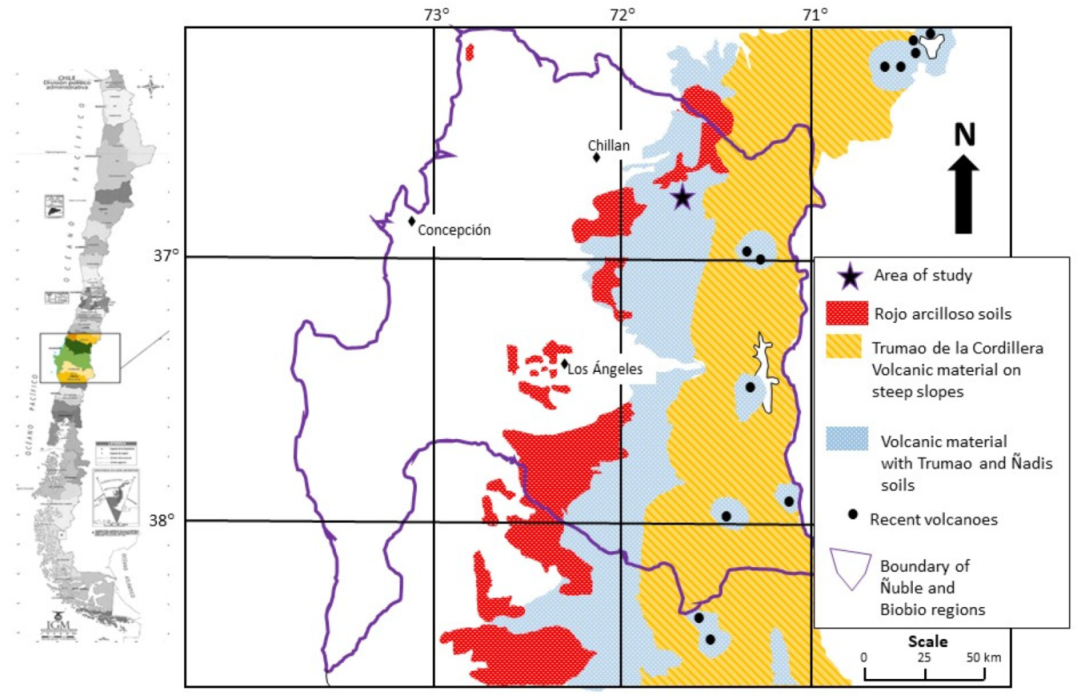
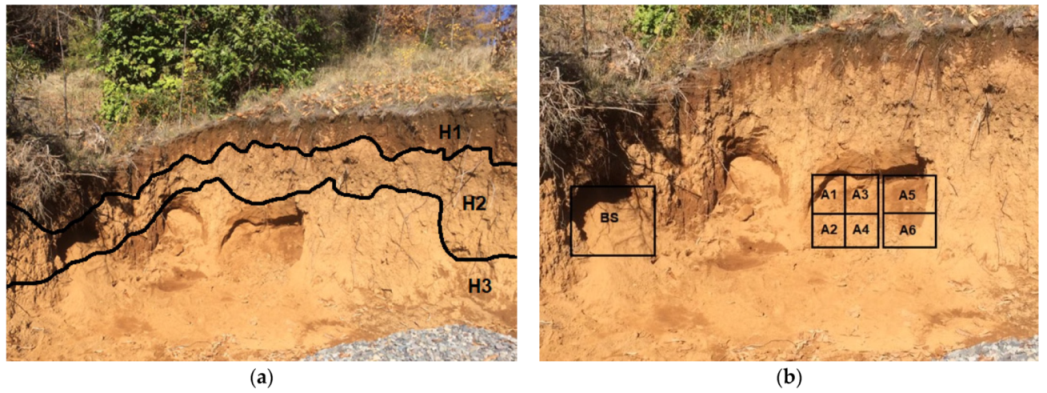
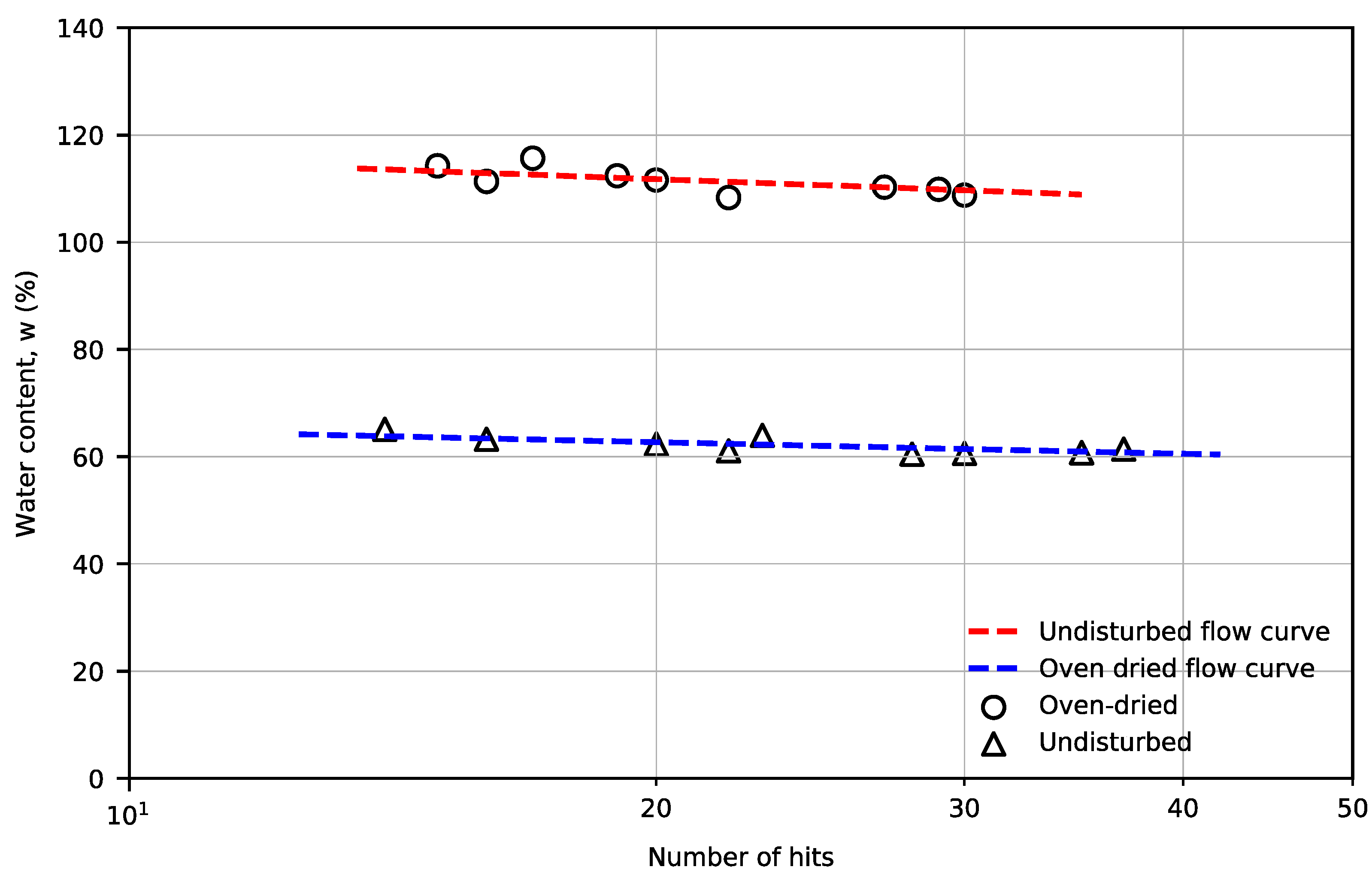
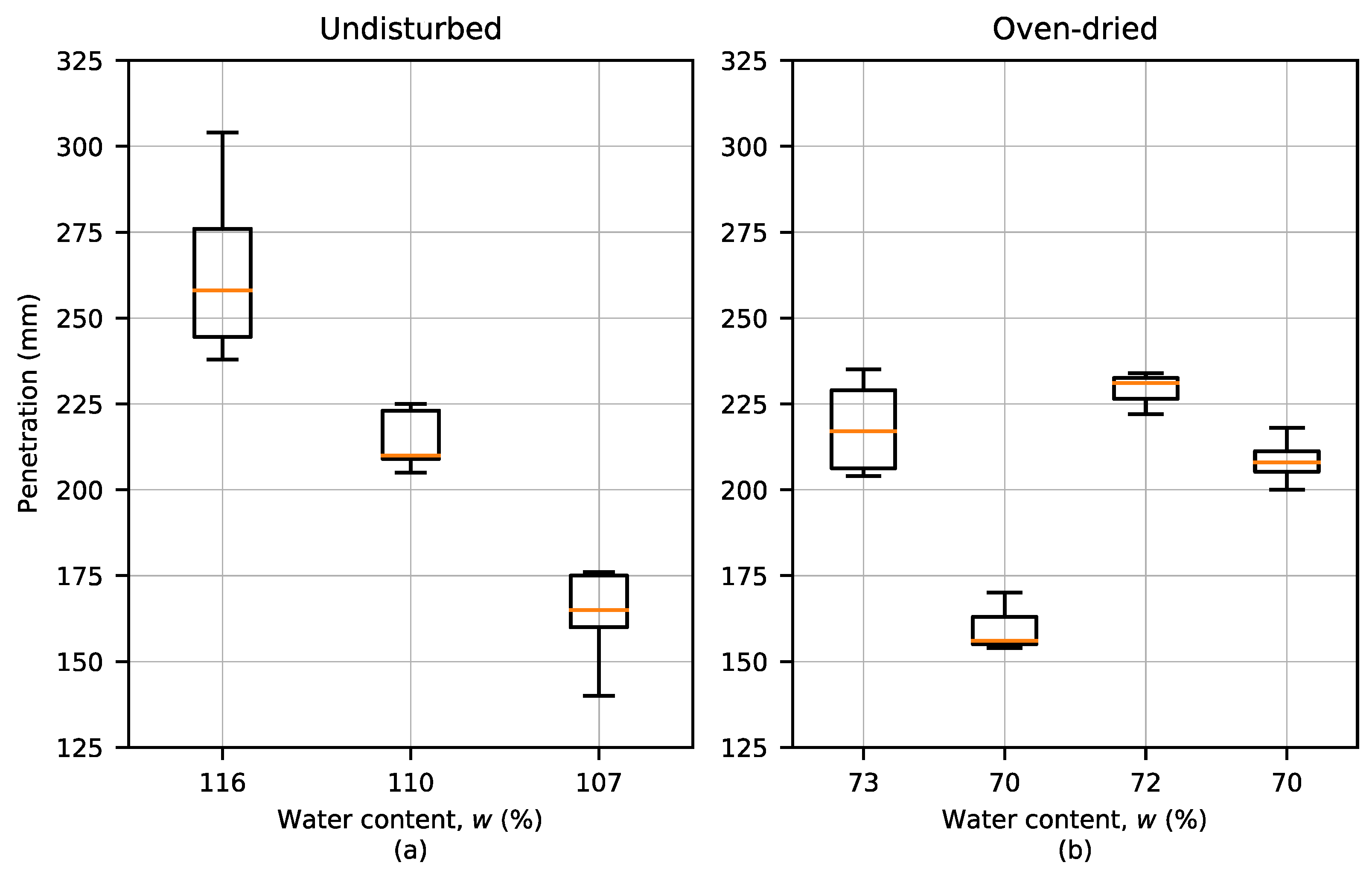

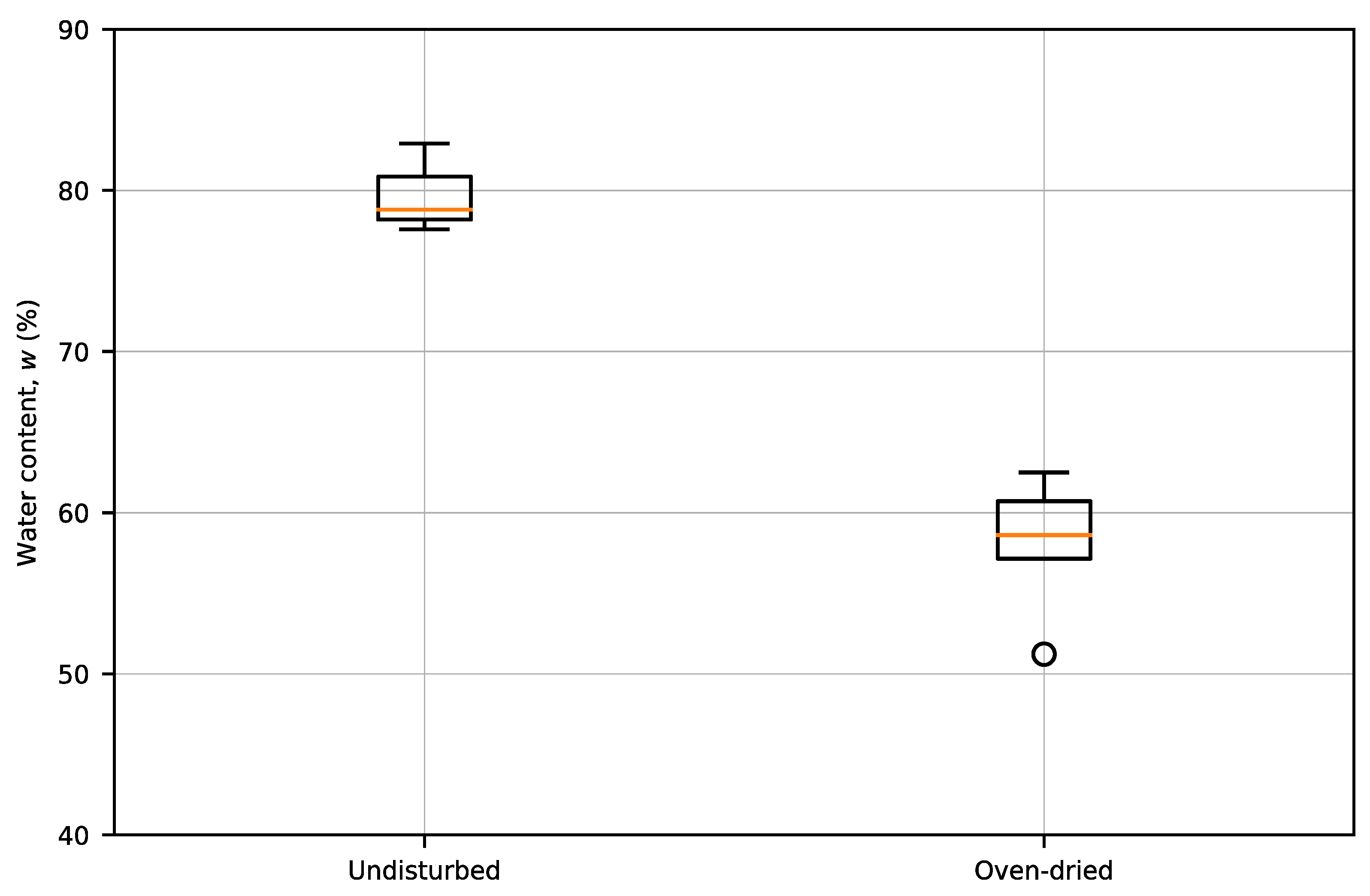
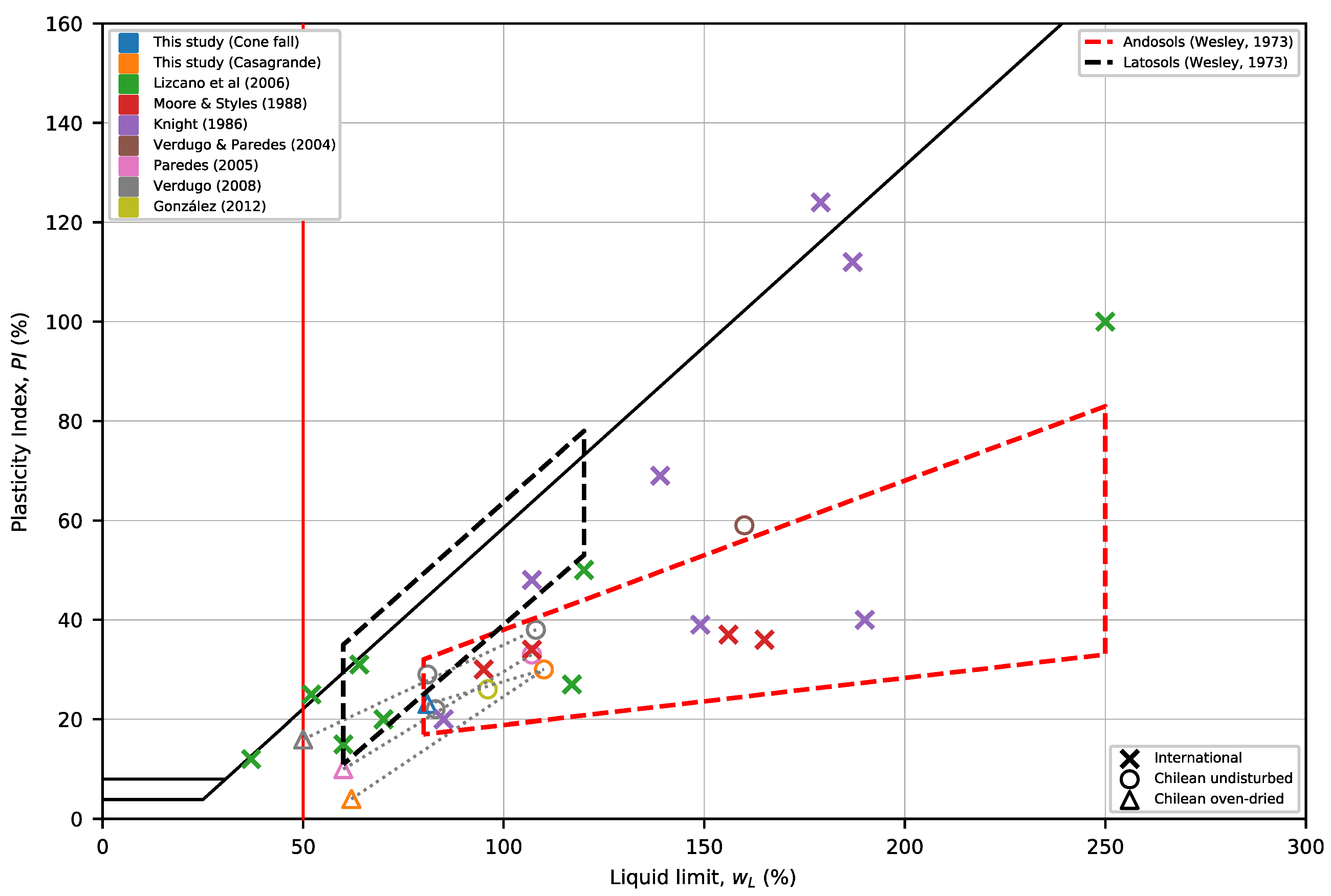
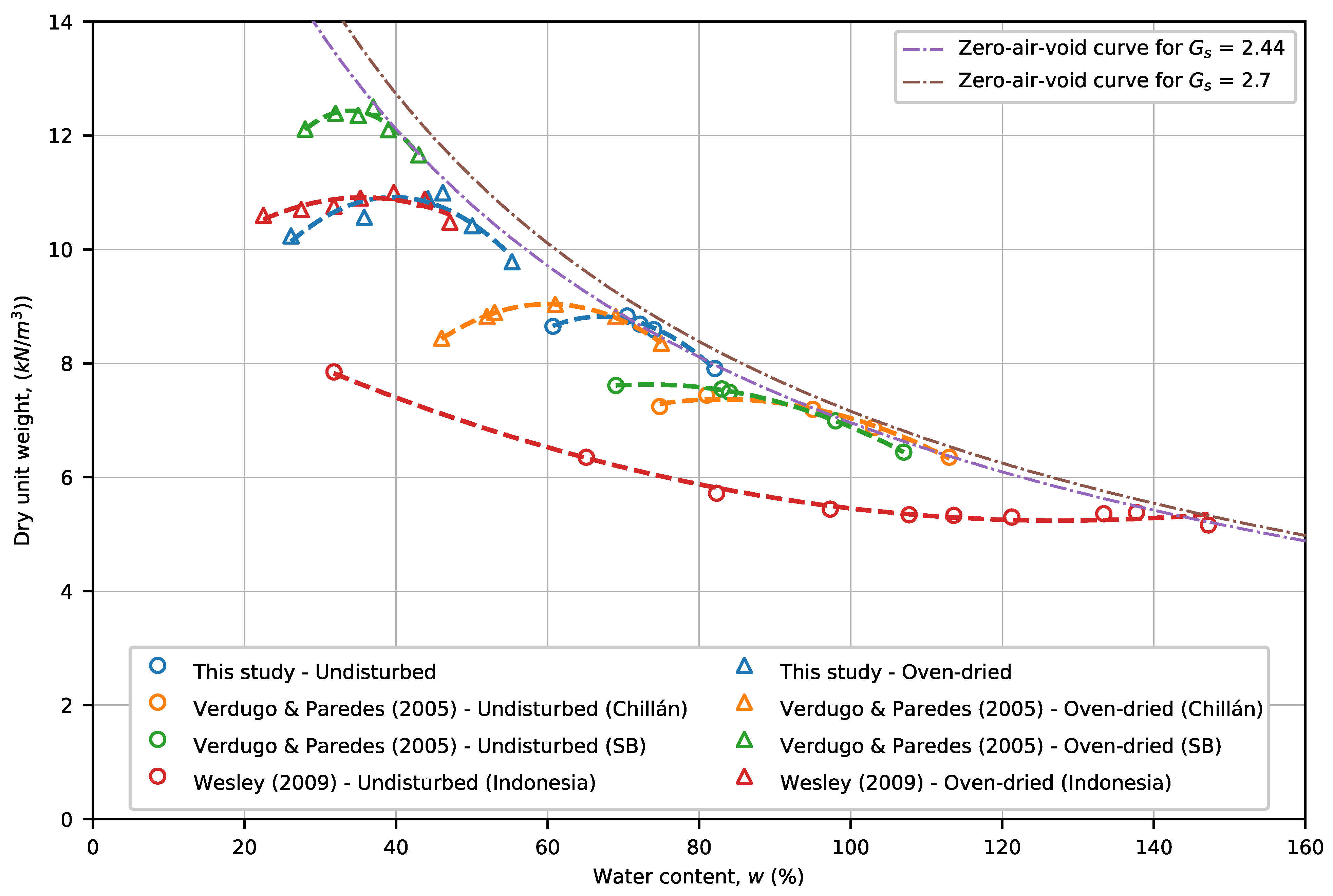

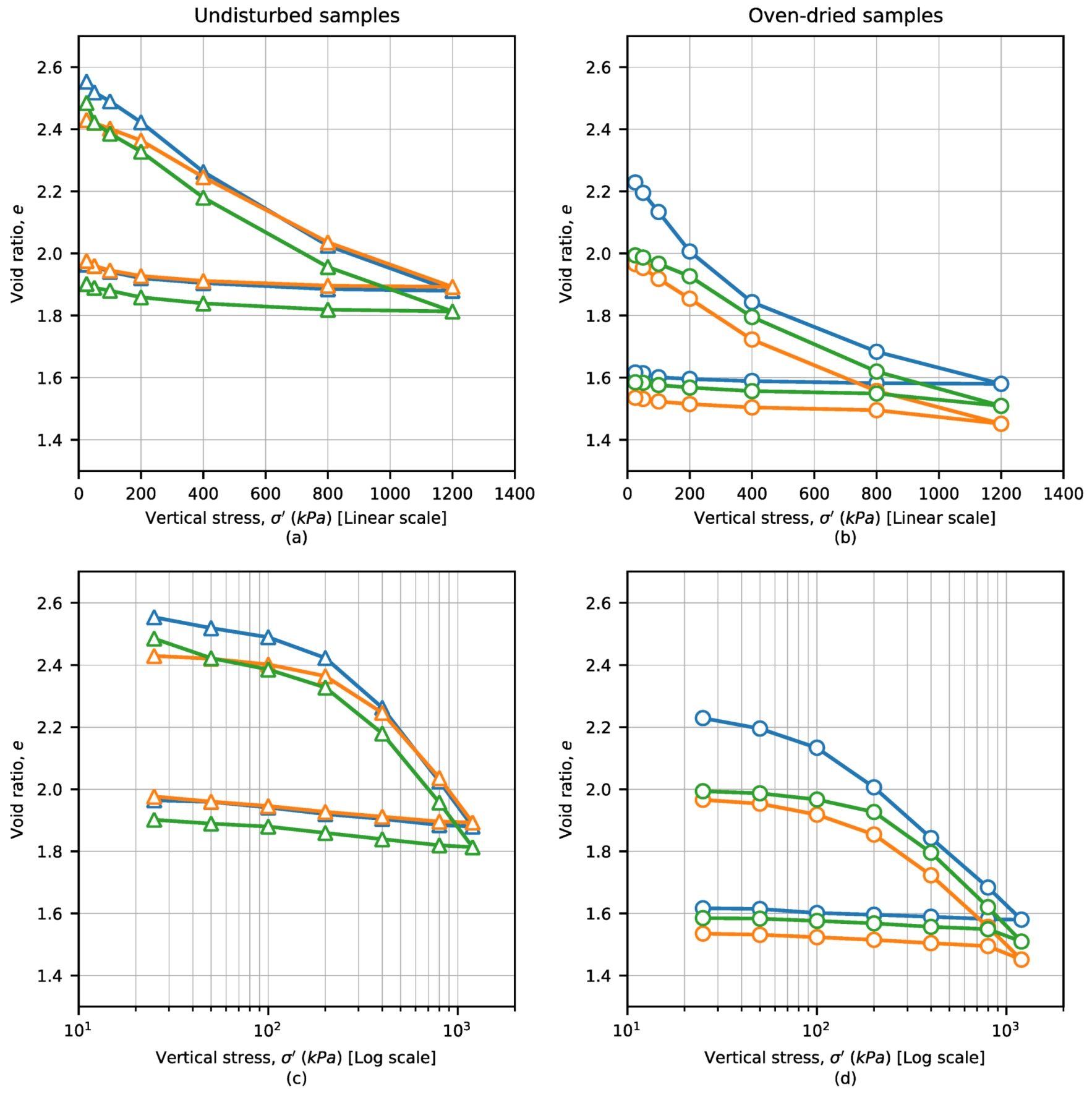
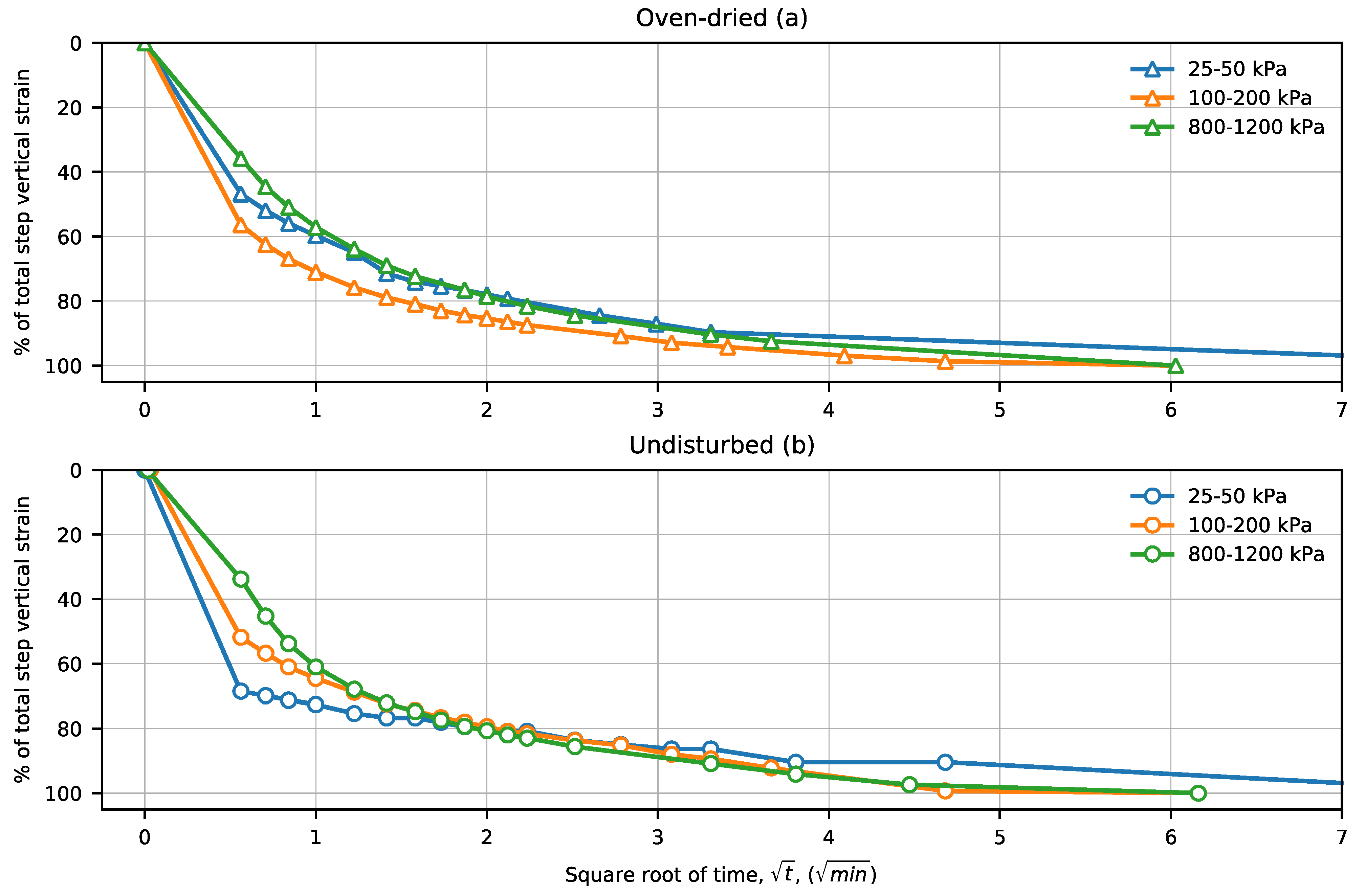
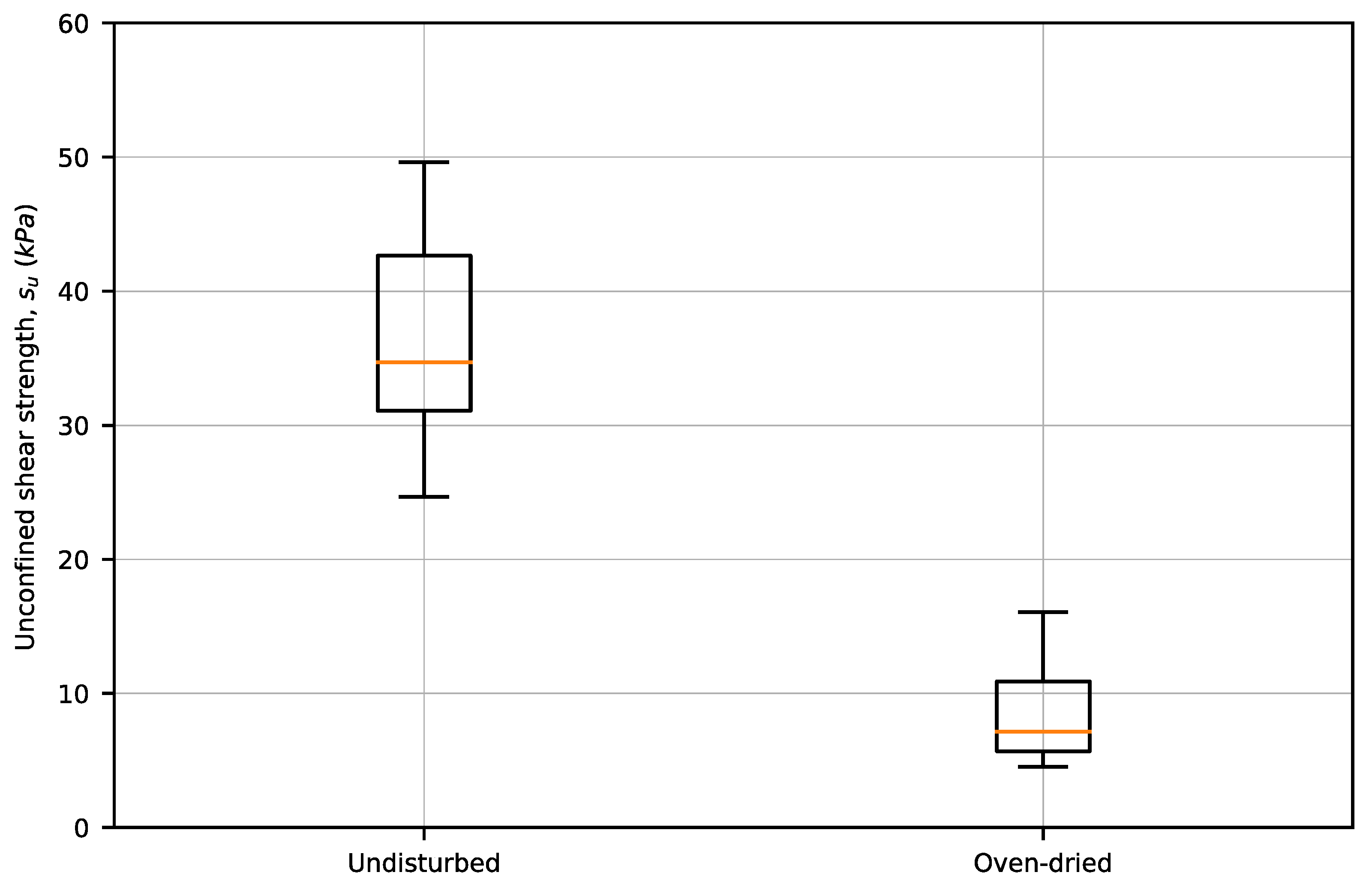
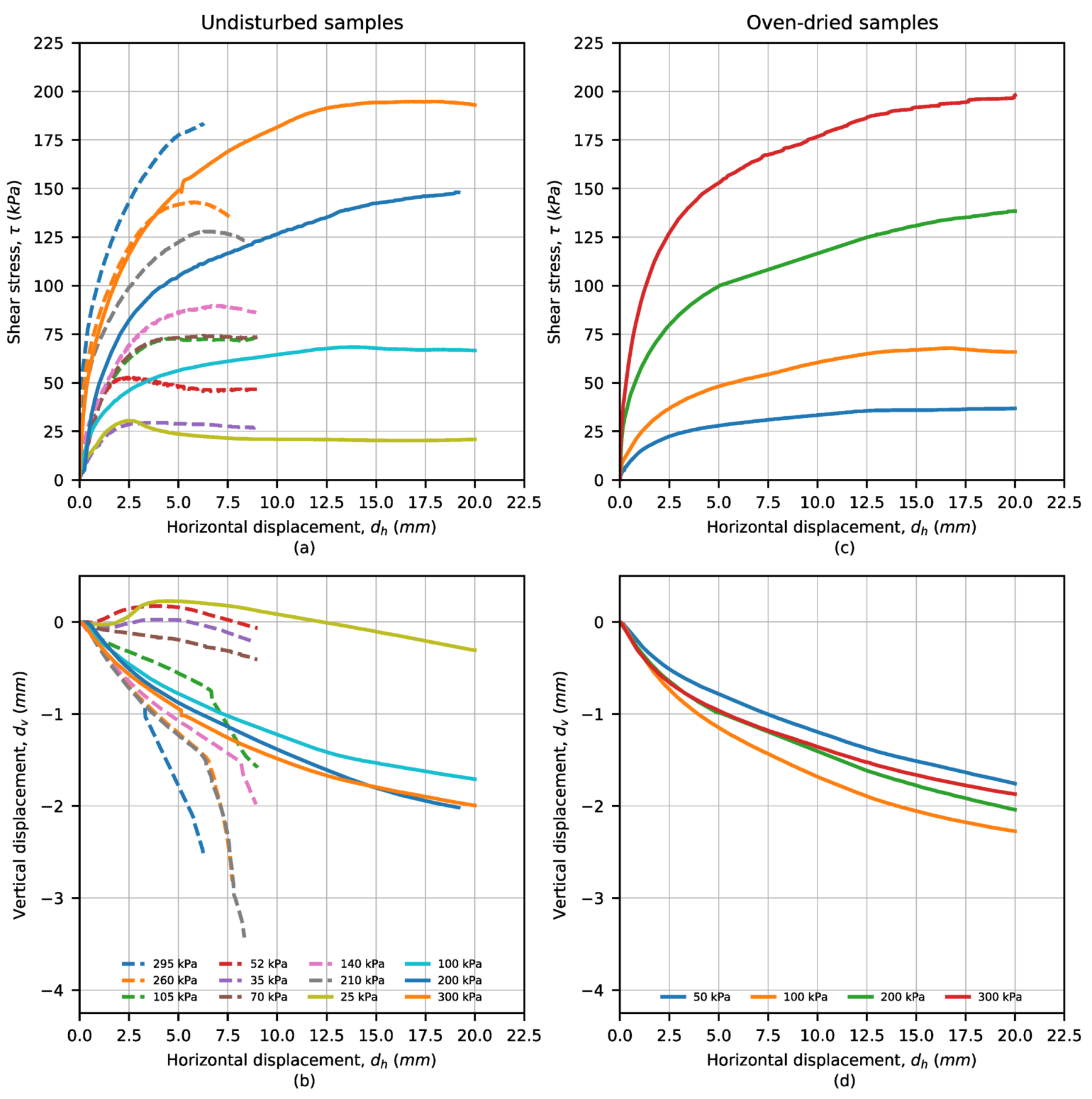

| Horizon | Description |
|---|---|
| H1 | Light-brown colored sandy silt, with low-to-medium plasticity in its original state. Medium humidity. Large amounts of roots. Material easily disintegrated into dust due to its high degree of weathering. |
| H2 | Light-brown colored sandy silt, with medium plasticity in its original state. Medium–high moisture content (challenging to estimate in the field). Medium–low amount of roots. The weathering degree of the soil confers its disintegrated features. |
| H3 | Light–brown colored sandy silt, with medium-to-high plasticity. Medium–high moisture. Null or very low amount of roots. |
| Property | Unit | State | Test Standard | |
|---|---|---|---|---|
| Undisturbed | Oven-Dried | |||
| Fine content | % | 87 | 89 | ASTM D422 |
| Liquid limit (Casagrande) | % | 110 | 62 | ASTM D4318 |
| Liquid limit (Cone fall) | % | 110 | 83 | BS 1377-2 |
| Plastic limit | % | 80 | 58 | ASTM D4318 |
| Classification (USCS) | - | MH | MH | ASTM D2487 |
| Specific gravity | - | 2.49 | 2.44 | ASTM D854 |
| Modified Proctor | 9.76 | 10.95 | ASTM D1557 | |
| Modified Proctor | % | 64 | 46 | ASTM D1557 |
| CBR | % | 15.4 | 29.4 | ASTM D1883 |
| Initial void ratio () | - | 2.44–2.57 | 2.25–1.97 | ASTM D 2435 |
| Coefficient of compressibility () | kPa−1 | 6.42·10−3 | 9.7·10−3 | ASTM D2435 |
| Unconfined shear strenght | kPa | 36.3 | 8.8 | ASTM D2166 |
| Sensitivity | % | 4.15 | - | |
| Frition angle | ° | 29 | 33 | ASTM D3080 |
| Cohesion (c) | kPa | 18.7 | 4.3 | ASTM D3080 |
Publisher’s Note: MDPI stays neutral with regard to jurisdictional claims in published maps and institutional affiliations. |
© 2021 by the authors. Licensee MDPI, Basel, Switzerland. This article is an open access article distributed under the terms and conditions of the Creative Commons Attribution (CC BY) license (https://creativecommons.org/licenses/by/4.0/).
Share and Cite
Romero-Mancilla, P.E.; Montenegro-Cooper, J.M.; King, R.W.; Lapeña-Mañero, P.; García-Casuso, C. Experimental Investigation on the Influence of Oven-Drying on the Geotechnical Properties of Volcanic Ash-Derived Residual Soils. Appl. Sci. 2021, 11, 11708. https://doi.org/10.3390/app112411708
Romero-Mancilla PE, Montenegro-Cooper JM, King RW, Lapeña-Mañero P, García-Casuso C. Experimental Investigation on the Influence of Oven-Drying on the Geotechnical Properties of Volcanic Ash-Derived Residual Soils. Applied Sciences. 2021; 11(24):11708. https://doi.org/10.3390/app112411708
Chicago/Turabian StyleRomero-Mancilla, Pablo Eduardo, José Miguel Montenegro-Cooper, Robert W. King, Pablo Lapeña-Mañero, and Carmen García-Casuso. 2021. "Experimental Investigation on the Influence of Oven-Drying on the Geotechnical Properties of Volcanic Ash-Derived Residual Soils" Applied Sciences 11, no. 24: 11708. https://doi.org/10.3390/app112411708






